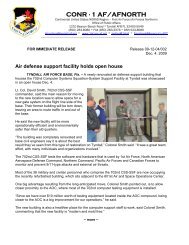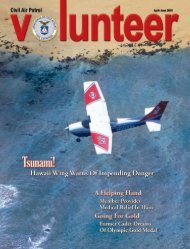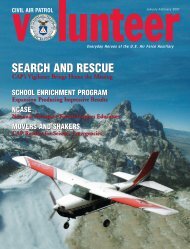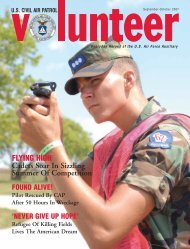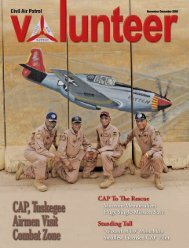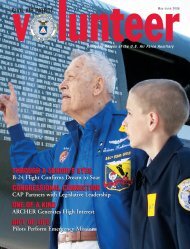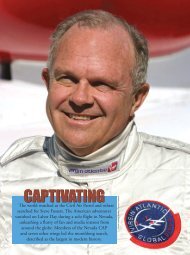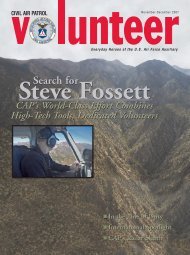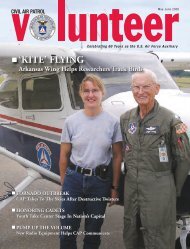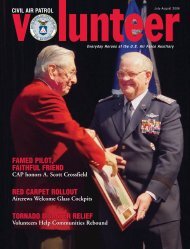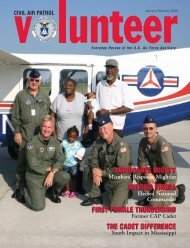GIVING BACK
Hi-res - CAP Volunteer Now
Hi-res - CAP Volunteer Now
- No tags were found...
You also want an ePaper? Increase the reach of your titles
YUMPU automatically turns print PDFs into web optimized ePapers that Google loves.
Harmon heaped praise on Cindy Sweitzer, the<br />
Suwannee Valley squadron’s deputy commander for<br />
cadets. “She was on top of everything,” she said.<br />
“1st Lt. Cindy Sweitzer was the real leader of this<br />
effort, and I think she deserves some special recognition,”<br />
said Lt. Col. Fred Swearingen, Group 2’s deputy<br />
commander-west, who is recommending a Unit Citation<br />
for the Suwannee Valley squadron, which Mark and<br />
Cindy Sweitzer helped start about a year ago.<br />
“I think this shows how CAP working with the community<br />
can have a positive impact,” Swearingen said,<br />
“and our willingness to use our resources to help resolve<br />
what could have been a much more dangerous situation.”<br />
Swearingen also was able to participate in the relief<br />
efforts as he traveled with the group several times during<br />
their deliveries to the forward staging area.<br />
The firefighters at Station 40 appreciated CAP’s support.<br />
More than 800 firefighters and personnel worked<br />
out of the station’s forward staging area at the height of<br />
the emergency.<br />
Other Civil Air Patrol members in Florida and<br />
Georgia provided aerial support for the nearly twomonth<br />
firefighting effort.<br />
Lt. Col. Doug Kelley, commander of Florida Wing’s<br />
Group 1, which covers the panhandle of Florida from<br />
just west of Tallahassee to Pensacola, provided aerial surveillance<br />
photos to those on the ground.<br />
The Civil Air Patrol has an agreement with Eglin Air<br />
Force Base in northwest Florida to fly daily sorties for<br />
fire spotting, according to Florida Wing Commander<br />
Col. Patrick O’Key. Those flights, made by Kelley and<br />
other members of Group 1, were especially important in<br />
tracking the wildfires.<br />
“This is pretty severe,” Kelley said. “We use the airplanes<br />
to tell where they break out.”<br />
Kelley said CAP’s communication equipment also<br />
expedites the firefighting efforts. “Our communications<br />
equipment allows us to talk to firefighters on the<br />
ground,” he said. “We’re also able to provide real-time<br />
photos that tell them exactly what’s happening.”<br />
Even when Civil Air Patrol personnel were not<br />
involved as members, some, like Capt. Bryan Smith of<br />
the Gainesville Composite Squadron, were able to help<br />
out as part of their regular job. While not flying for<br />
CAP, Smith’s job as a helicopter pilot for the Gainesville<br />
Photo by Lt. Col. Doug Kelley, Florida Wing<br />
U.S. Civil Air Patrol aircraft in<br />
northern Florida provided<br />
instant aerial feedback to<br />
firefighters on the ground.<br />
U. S. Civil Air Patrol Volunteer 21 July-August 2007



